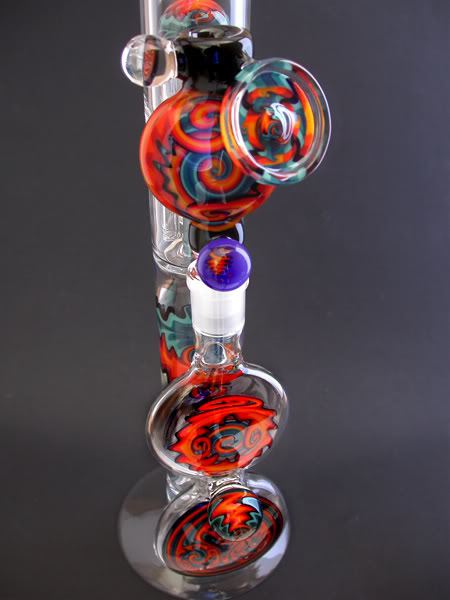The Art and Culture of Dope Bongs: A Comprehensive Guide
Introduction to Bongs
In the world of smoking, few devices are as iconic and culturally significant as the bong. Often associated with the cannabis culture, bongs have transcended their utilitarian purpose to become symbols of relaxation, creativity, and social connection. This article delves into the fascinating world of dope bongs, exploring their history, design, and the experience they offer to users.
The History of Bongs

The origins of bongs can be traced back thousands of years. Historical records suggest that the use of water pipes for smoking dates back to ancient civilizations in Asia, particularly in regions like China and India. The word “bong” itself is believed to have originated from the Thai word “baung,” which refers to a cylindrical wooden tube used for smoking. Over the centuries, the design and materials of bongs have evolved significantly, reflecting changes in culture and technology.
In the 20th century, existing became popular in the Western world, particularly during the counterculture movement of the 1960s and 1970s. As cannabis use became more widespread, so did the popularity of bongs. They were embraced not only for their functionality but also for their artistic potential, leading to the creation of elaborate and colorful designs. Today, bongs are available in a wide variety of shapes, sizes, and materials, catering to both casual users and serious collectors.
How Bongs Work
Bongs operate on a simple principle: water filtration. When a user inhales through the mouthpiece, smoke is drawn down through the water chamber. This process cools the smoke and filters out some impurities, providing a smoother smoking experience compared to dry pipes. The water also helps to moisten the smoke, making it less harsh on the throat and lungs.
The basic components of a bong include the bowl, downstem, water chamber, and mouthpiece. The bowl is where the cannabis is placed and ignited. The downstem connects the bowl to the water chamber, allowing the smoke to travel through the water before reaching the user. The mouthpiece is the opening through which the user inhales the smoke. Some bongs also feature additional components, such as percolators, which further enhance filtration and diffusion of the smoke.
Types of Bongs
The diversity of bongs available today is astounding. They can be categorized based on their materials, design features, and functionality. The most common materials used for bongs include glass, acrylic, ceramic, and silicone. Each material offers unique advantages and drawbacks.

Glass Delivered are often favored for their aesthetic appeal and purity of flavor. They come in a wide range of designs, from simple and functional to intricate and artistic. Acrylic bongs, on the other hand, are more durable and less expensive, making them a popular choice for beginners. Ceramic bongs offer a unique look and can be quite decorative, while silicone bongs are virtually indestructible and easy to clean, making them ideal for on-the-go use.
In addition to material, bongs can also vary in design features. Some bongs are equipped with percolators, which create additional bubbles in the water for improved filtration. Others may have ice catchers, allowing users to add ice cubes for an even cooler smoking experience. The variety of designs available means that users can find a bong that suits their personal style and smoking preferences.
The Social Aspect of Bongs
Bongs are often associated with social smoking, where friends gather to share a smoking session. This communal aspect of using a bong can enhance the experience, fostering a sense of connection and camaraderie among users. Passing around a bong can become a ritual, with each person taking turns and sharing stories, laughter, and good vibes.
The culture surrounding bongs is rich and varied, with many enthusiasts taking pride in their collections. Some individuals even customize their bongs, adding personal touches or modifications to enhance their functionality or aesthetic appeal. This creativity is a testament to the bond that many users feel with their smoking devices, viewing them as more than just tools but as expressions of their identity and lifestyle.
Maintaining Your Bong
To ensure a great smoking experience, proper maintenance of your smoking pipe is essential. Regular cleaning helps to prevent the buildup of resin and other residues that can affect the flavor and smoothness of the smoke. Cleaning your bong can be done using simple household items like isopropyl alcohol and salt, or you can purchase specialized cleaning solutions designed for bongs.
To clean a bong, start by disassembling it and emptying the water. Rinse all parts with warm water to remove loose debris. Then, fill the bong with isopropyl alcohol and add a tablespoon of salt. Cover the openings and shake gently to dislodge any stubborn residue. Rinse thoroughly with warm water afterward, and your bong will be ready for use again.
Conclusion: The Enduring Appeal of Dope Bongs
Dope bongs remain an enduring symbol of cannabis culture, offering users a unique and enjoyable way to experience their favorite herb. With a rich history, diverse designs, and a strong social component, bongs continue to captivate both novice and experienced smokers alike. Whether you are looking for a simple device for personal use or an intricate piece of art to showcase in your collection, there is a bong out there for everyone.
As the culture surrounding bongs evolves, so too does the appreciation for the craftsmanship and creativity involved in their design. From the materials used to the intricate details of each piece, bongs are not just tools but works of art that reflect the individuality of their owners. Embracing the world of dope bongs means embracing a lifestyle that values relaxation, creativity, and connection with others.
Leave a Reply